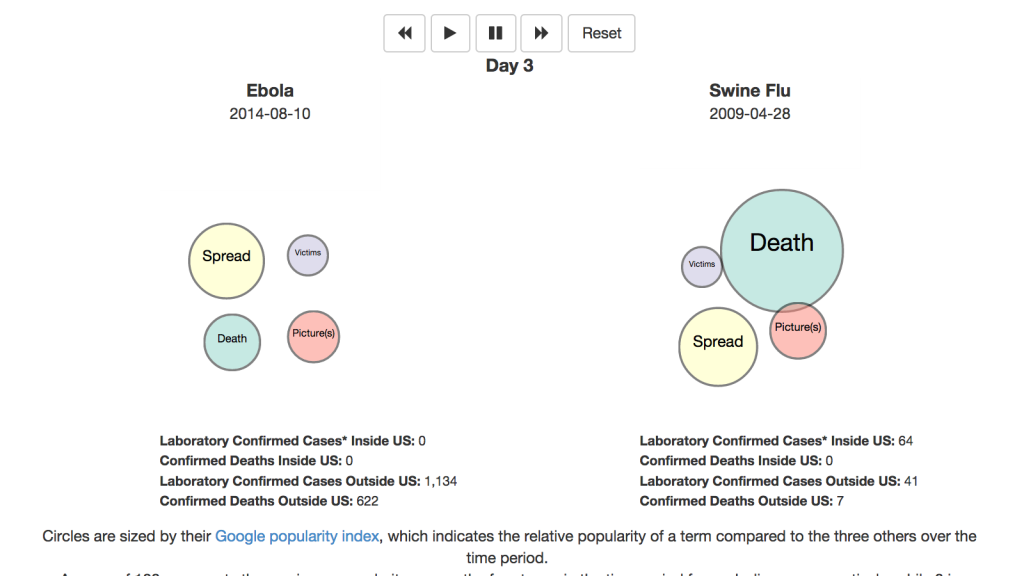What some people call the “epidemiology of emotions” surrounding Ebola is difficult to measure — polls give us a glimpse of it, but it’s an incomplete picture. A Gallup poll conducted from October 4 to 5, right after the first case of Ebola was diagnosed in the United States, found that only 22% of Americans worry about themselves or someone in their family contracting the Ebola virus, and 49% say that it’s not likely to happen at all. The Gallup report compares the public’s reaction to Ebola to its response to the Swine Flu (H1N1) outbreak in 2009. For the H1N1 virus, 8-25% of people polled were worried about getting the virus (the numbers vary depending on what point in the outbreak the participants were polled).
Here’s the big difference: When the participants were polled about Ebola, the CDC believed that only six Americans might have the virus; when the polling for H1N1 happened, the number of potentially affected Americans, according to the CDC, ranged from 14 million to 34 million, though laboratory confirmed cases were in the low thousands.Picture one person, one reader of the news, and what she might be thinking as the Ebola story unfolds in the media alongside the statistics about the spread of the disease. One portal into this universe of anxiety is the Google search box — who of us hasn’t spent an anxious evening typing questions about health and wellbeing there, looking for WebMD pages about the flu or some strange rash, or perhaps the likelihood that Ebola will spread to the United States? Or maybe it is simple, non-anxious curiosity that motivates her, voyeurism for the suffering in poor, distant countries. Or perhaps it is a search not for explanations, but for proof of the disease’s existence in a picture or fact from the CDC.While not a definitive method for characterizing our fear, comparing the popularity of some queries about Ebola to others is an interesting place to contour it. So I started with my own doubts, curiosities, and anxieties: “death,” “spread,” “picture(s)” and “victims.” These words seemed to capture my guesses about the nature of the disease’s existential threat, the voyeurism and visual curiosity associated with it, and the risk mitigation that we attempt by tracing its path.
At TBQ, we decided to see how the popularity of my queries among Americans changed over the first 60 days of the epidemic — from the World Health Organization’s declaration of a global emergency, to the first case reported in the United States. Then we applied the same queries over a comparable time window during the H1N1 epidemic in 2009, from the United States’ declaration of a domestic public health emergency in April to sixty days later. We examined the differences between the questions Americans had about Ebola — a disease that started and spread far away from the United States in impoverished countries with histories of misrepresentation by the American media — and H1N1, which originated and spread in the U.S. and its bordering countries. Overlaying the headlines of the period provides some insight into the media climate at the time and how these queries rose and fell with their stories.
Comparing the search terms for the diseases, a few oddities emerged. For instance, there was the surprising relationship between the popularity of “death” and “spread” in the Ebola and H1N1 scenarios. The first American died of H1N1 four days after the United States called a public health emergency. Queries for “death” subsequently ballooned, abounded, and remained as a persistent echo long after other concerns about spread vanished; meanwhile, the disease was spreading at a rapid average rate of about 357 laboratory confirmed cases per day in the United States and about 572 laboratory confirmed cases per day outside of the United States, with only a little over 0.4% of these cases cumulatively ending in death. Somehow the queries about spread quieted down just as the disease exponentially took hold of more people.
Contrast this to Ebola, which is a much deadlier disease than Swine Flu. In the sixty-day period, about half of the people who were confirmed to have contracted the disease died. However, its spread was much slower than the spread of Swine Flu, although alarming in comparison to the small populations of countries like Sierra Leone or Liberia. Still, why did Americans’ queries for spread outpace queries for death in this period? And unlike Swine Flu, the peak of query activity was towards the end of the period, when a case finally appeared in the United States. Yet somehow spread was still more salient than death, even as people had observed the shocking mortality rate in West Africa.
Then, there were also things that didn’t seem so strange: Given the gruesome nature of Ebola, that “picture(s)” was a much more prevalent search term for Ebola than for Swine Flu made sense. Still I couldn’t help but think about the history that West African countries have had with people in the developed world experiencing their citizens’ pain voyeuristically through a certain type of non-specific, mawkish photography that charity, news, and aid organizations often rely on. It leads you to question, Why do we want to see Ebola patients in West Africa when we didn’t care so much about pictures of Swine Flu patients taken in the United States? What we might be after is the assurance — visual proof — that the conditions in West African countries are so bad that it must be the context of the disease, rather than the disease itself, that is the real catalyst for the destruction around the Ebola crisis. That way, we can assure ourselves that the ravaging of our society by disease can’t happen.
These are only a few of many possible observations. Reader, we’ve presented you with the results of our mini-experiment with hope that you’ll use them to examine this nebulous concept of public fear. As the questions become greater in number, as we take a good look at what we might be afraid of given the particulars of a certain disease, we can start to counteract the frantic, even random, quality of our public emotions. President Obama calls for us not to give into “Ebola hysteria.” This is our response. – Alexia Nader
Click the picture below to start the visualization:
•
 Sandy Nader is the resident data scientist for The Brooklyn Quarterly. She received her M.A. in Applied Statistics from Columbia University.
Sandy Nader is the resident data scientist for The Brooklyn Quarterly. She received her M.A. in Applied Statistics from Columbia University.
 Alexia Nader is a senior editor at The Brooklyn Quarterly and a freelance writer. She has contributed to the Los Angeles Review of Books, The Nation, and Oxford American, among other publications. She lives in San Francisco.
Alexia Nader is a senior editor at The Brooklyn Quarterly and a freelance writer. She has contributed to the Los Angeles Review of Books, The Nation, and Oxford American, among other publications. She lives in San Francisco.

